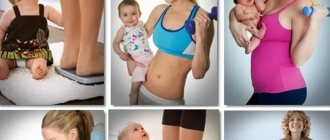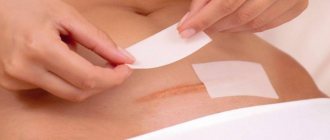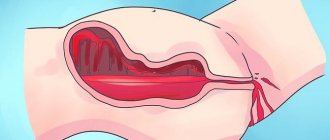Home / After childbirth / How long does it take for the uterus to contract after childbirth and is it possible to speed up this process?
81386
0
The long-awaited moment has come for any mother when her baby is born. Troubles and caring for the child lie ahead. It is at this moment that the recovery stage begins for every woman: contraction of the uterus after childbirth. This period begins immediately after the baby is born and usually lasts from 6 to 8 weeks. During this time, all those changes that took place throughout the entire period of pregnancy undergo a reverse process.
Special situations
Second birth
C-section
"Twin" birth
Artificial birth
- 446
Want to discuss the article? Don't miss a single comment!
Receive the latest opinions by email
We advise you to read
How long does the second birth last?
How long does labor last for first-time mothers?
How does the second birth go?
How to get pregnant with a bent uterus
When do periods begin after childbirth while breastfeeding?
Is it possible to get pregnant immediately after menstruation?
Benefits, payments and benefits for low-income families in 2020: complete list
Free medicines for large families: list and conditions for receiving them
Taxes for large families in 2020
Benefits, benefits, payments to a large family in St. Petersburg in 2020
Children's DIY paper crafts for the New Year: top 5
Turkey for children: recipes with photos (menu from 2 years)
Rating of the best dolls for girls 2020: 12 interactive and silicone new products
Toys for children over 3 years old: what toys are interesting to a child in 2020?
How long does involution last?
Over the course of nine months, the uterus stretches 25 times its normal size. After the birth of the child, she needs to return to her original state. In this case, the walls of the organ thicken, it takes the shape of a ball, and hypertrophied muscle fibers decrease in volume.
Whether recovery is proceeding normally is determined by measuring the height of the uterine fundus. The descent of the organ begins from the moment the placenta leaves and proceeds at a rate of approximately a centimeter per day.
- in the first days after the birth of the baby, the bottom is located at the level of the navel;
- on the fifth day - in the middle between the womb and the umbilical cavity;
- on the tenth day - behind the womb.
After 6–8 weeks, the position and size of the uterus reaches its prenatal state.
How to relieve attacks
If the pain syndrome is too severe, a nursing mother should not take the first painkillers she comes across, they may contain components harmful to the baby. If you can’t stand it, you need to see a doctor who will give you a prescription for an analgesic that is not dangerous for the child. Such plant-based formulations have a sedative and calming effect. A light massage of the lower abdomen may also help.
Another safe way is labor breathing, which allows you to enrich muscle tissue with oxygen and reduce pain.
Signs of a slow recovery process
An important indicator of the normal progress of rehabilitation is lochia. During the first week they are as abundant and bloody as possible. Then the discharge gradually lightens, there is less of it, and it ends by the sixth week. If their normal discharge is disrupted, the cervical canal may close with a blood clot, which will reduce the intensity of the contractile process.
This deviation is called subinvolution, or “lazy uterus”. But not only problems with lochia can cause this condition. Risk factors are:
- large fetal weight;
- multiple pregnancy;
- low attachment of the placenta;
- weak labor process;
- difficult pregnancy or childbirth;
- physical inactivity of a young mother.
Contractions may be completely absent if the uterus is bent, damage to the birth canal, polyhydramnios, inflammation and neoplasms in the reproductive organs.
Serious problems can be identified by foul-smelling dark discharge, a rise in temperature to 38 degrees and swelling of the uterus. If such symptoms appear, you need to contact a gynecologist.
What complications may arise?
The rapidity of liberation from birth consequences causes various complications to arise. These include:
- suppuration of the placenta remains;
- formation of inflammatory diseases;
- lactation disturbance – decrease in the amount of milk, change in composition;
- the likelihood of a short-term pregnancy.
Postpartum depression is common. Symptoms - anxiety, irritability, feelings of panic, insomnia - disappear without medical intervention after 5 days. Protracted manifestations of a painful nature require consultation with a neurologist or gynecologist.
How to speed up rehabilitation
If, after the birth of a baby, multiparous women do not have lochia and cramps in the lower abdomen, this is not always the norm. In this case, it is necessary to help the uterus contract.
What to do in this situation:
- Breastfeed your baby. Nipple irritation stimulates the production of prolactin, which promotes uterine contractions.
- Try to move more. If the birth was difficult, consult your doctor about possible stress before starting physical activity.
- Sleep on your stomach, especially during the day.
- Observe the rules of hygiene of the reproductive organs.
- Empty your bladder as soon as you feel the first urge. The rate of uterine contraction depends on the frequency of bowel movements.
Health care
To enhance the contractile activity of the uterus, an artificially created hormone, oxytocin, is prescribed. It stimulates smooth muscles, speeding up the process. The drug enhances the release of prolactin, which is responsible for milk production. Breastfeeding accelerates the processes of normalization of the female body.
Administration of oxytocin - intravenous, intramuscular, sometimes injections are given subcutaneously. In weakened women, uterine contraction after cesarean section is achieved by drip infusion of the drug.
The group of oxytocyons includes medications - tablets, injections - containing various additives. The appropriateness of their appointment is determined by the attending physician.
What exercises will help with a “lazy uterus”
Strengthening the muscles of the vagina, sphincter of the bladder and pelvic floor, as well as restoring the tone of the uterus, is facilitated by training developed by gynecologist Arnold Kegel:
- Clenching and unclenching the pelvic floor muscles.
- Alternately accelerated contraction and relaxation of the muscles of the vagina and pelvic floor.
To get the benefits of exercise, you need to exercise regularly. You need to start training with ten repetitions, gradually increasing their number to fifty.
Postpartum gymnastics is also useful. If you should start active sports after the cessation of lochia, then a set of light exercises can be performed by a woman who has recently given birth:
- Lie on your back with your legs together. Slowly bend and straighten your knees.
- Straighten your legs and stretch your toes towards your torso.
- Tighten and relax your feet, tuck and straighten your toes.
- Breathe with your stomach while lifting the abdominal wall, helping to “expel” the air with your hands from the pubis to the umbilical cavity as you exhale.
Train regularly, without sudden movements, gradually increasing the load. If discomfort occurs, stop exercising.
Is it possible to use traditional methods?
Taking tinctures of medicinal herbs will help the uterus contract and recover better. You can try these recipes:
- Four large spoons of shepherd's purse are steamed in 500 ml of boiling water. Leave under a warm towel for a couple of hours and drink in small sips throughout the day.
- Two large spoons of alba are poured with half a liter of cool water overnight. In the morning the composition is filtered. The tincture is taken three times a day, half a cup.
- Two small spoons of geranium are poured with 500 ml of cold water overnight. Drink the filtered product in small sips from morning to evening.
Before using folk remedies, consult your doctor so as not to worsen the condition.
Mild pain during uterine contractions after delivery indicates that the recovery process is proceeding as normal. But if the pain is severe, you need to see a gynecologist. This may be a sign of inflammation or blood clots in the uterine cavity. Uncontrolled use of painkillers will only worsen the situation.
The female body does not return to normal after childbirth immediately: the work of all systems and organs is restored gradually over several months. The uterus, which “grows” together with the baby, “gets” the most (this organ can increase more than 500 times), so it is injured the most. To restore the uterus after childbirth, proper care, time, and supervision by a gynecologist are required.
The uterus gradually begins to contract after the birth of a child, and this process is purely individual for each woman, since each body needs “its own” time to recover.
Recovery after caesarean section
The period after surgical delivery includes a set of measures aimed at enhancing contractile activity and resuming normal activity of the body.
- Antibiotic therapy – prevention of inflammation.
- Bandage – prevention of uterine prolapse.
- Diet – normal food is allowed on the fifth day after surgery. In the first days, water, chicken broth, low-fat kefir.
- Intimate relationships - sex is contraindicated until the wound surface has completely healed due to the high risk of infection.
After discharge from the maternity hospital, the woman is registered at the dispensary. Observed by a gynecologist for two years after cesarean section.
It is not uncommon for discharge, accompanied by pain, to continue for more than eight weeks. This is considered a deviation from the norm. A gynecologist can determine why the uterus does not contract after childbirth. You should contact him if you have an existing problem.
The doctor will prescribe medications. It will be useful to perform special exercises. You can use traditional medicine.
To stimulate contraction of the uterus, the doctor performs an internal massage every 2 hours immediately after childbirth. Due to her individual organic structure, a woman feels pain. The procedure is necessary to improve the natural state.
- With your doctor's permission, you can perform simple physical exercises. They are aimed at reducing the recovery period.
- Lying on your back, bend/extend your knees with your legs brought together.
- In the same position, pull up your socks as much as possible.
- Sit on a gymnastic ball, tense your intimate muscles. Raise your right leg and hold it there for 10 seconds. Do the same with the left.
- In a sitting position, perform rotational movements with the pelvis 10 times in each direction.
- Sitting on the ball, swing your body left and right.
- Curl your toes throughout the day.
Exercise is prohibited for women who received stitches during childbirth. Execution requires their complete healing.
The beginning of the 10th month of pregnancy is counted from the moment of birth of the placenta. The duration depends on the involution of the genital organs and tissues. In the postpartum period, a sense of motherhood is formed, female psychology and physical development radically change; at this stage, a woman should be patient and closely monitor her well-being.
Author of the article
arinkarinka25
While the woman is still in the maternity hospital, she moves little and lies more. In this position, the uterus will not actively contract, so doctors recommend that women who have had a natural birth lie more on their stomachs. This position will help the lochia come out easier. During the entire postpartum period, women are contraindicated in physical activity so as not to disrupt the recovery processes in the abdominal muscles.
Those who have had a caesarean section should not strain their stomach at all, so as not to break the suture. After an incision in the perineum during childbirth, you need to be careful with any movements that cause discomfort in the area of the sutures; it is forbidden to even sit in the first 2 weeks after birth.
How then to perform exercises to contract the muscles of the uterus if physical activity is prohibited at first? The fact is that exercises for contracting the uterus are in no way connected with the concept of physical education that we have.
Dear mommies, remember that you should not perform exercises that involve the abdominal muscles, and all other exercises should be very smooth and easy. At the slightest discomfort in the abdomen, even slight pain, stop the exercises and rest, try again later.
Many mothers try to run to the gym almost from the maternity hospital in order to quickly get into the long-awaited shape. This absolutely cannot be done, since the load on the abdominal muscles immediately after childbirth will lead to them stretching and nothing but plastic surgery will remove the belly.
But this does not mean that you cannot move and get up during the first 2 months after giving birth. Early activity for mom, on the contrary, is very useful.
If you move a lot (without overexertion), walking, this helps:
- Contraction of the uterine muscles and speedy restoration of the uterus;
- Improvement of the digestive system (no constipation);
- Restoring the tone of all muscles of the body;
- Improve your mood.
What exercises can you do to engage the muscles of the uterus without touching the abdominal muscles?
These are exercises from a lying position on your back or side. You may find some of the exercises a little difficult in the first few days. At the slightest discomfort and pain, give up a certain type of exercise and move on to others.
- Breathing exercises. Lie on your back on a flat surface. Legs can be slightly bent. Perform breathing exercises, first inflating the stomach and relaxing it, then move on to inflating the chest - breathing with the diaphragm, and relaxing it. Do alternately in a complex of 5 techniques. Inhale slowly through the nose, exhale slowly through the mouth.
- Kegel exercises. This exercise can be done with or without kegel balls. The point is to learn to control the muscles of the vagina and anus. Sit or lie down comfortably, then, concentrating, try to squeeze the vaginal muscles for a few seconds, as if you were holding back urination. Then relax. Do the same with the anus muscles - squeeze for a few seconds and relax. Then do it alternately. Over time, you will learn to do this easily and simply. This exercise not only stimulates contraction of the uterus, but also restores the muscles of the vagina, bringing it to its prenatal shape. Do 10-15 times in several approaches per day:
- Preparing to pump the press. You can’t pump up your abs yet, but you can prepare for it. Lie on your back, legs straight. As you inhale, rise up and lean on your arms bent at the elbows, with your palms at waist level. As you exhale, lie down in the starting position. It turns out like a semi-press. Do it 5 times.
- Socks. Exercise to prevent thrombosis. Lie on your back, legs straight. Pull your socks towards you, sometimes together, sometimes alternately. Perform 15 times with each leg.
- Light twist. This is an exercise for the transverse muscles. Lie on your back, raise your head to your chest, shoulders on the floor. Pull the socks towards you, while reaching with your right hand towards the left sock, then with your left hand towards the right sock. The main thing is that your shoulders do not come off the floor, otherwise there will be a load on the abs. Perform 3 times in each direction.
- On the side. Lie on your right side. The right leg is straight, and the left leg (the one on top) is half bent. Pull your left leg towards you as you inhale, pressing it to your stomach. As you exhale, extend your leg. Roll over to the other side and repeat with the other leg. Perform 2-3 times.
- Exercises for the pelvic floor muscles. Lie on your back, bend your legs at the knees. Raise your pelvis and draw in your stomach as you inhale. Stay in this position for 3-5 seconds. At the exit, lower yourself to the floor. Perform 3-5 times:
What is the uterus like after childbirth?
From the inside, the uterus after childbirth looks like a huge wound, which is maximally damaged at the placenta attachment site. In addition, blood clots and remnants of the fetal membrane remain on its inner surface. The uterine cavity should normally clear out during the first 3 days after birth.
After childbirth, the uterus stretches and increases in volume. Lochia (postpartum discharge) is released from it, bloody in the first days, lighter by the 4th day, by the end of the 3rd postpartum week they become more and more liquid and lighter and disappear completely by the 6th week.
We can talk about the restoration of the inner lining of the uterus after childbirth no earlier than the 3rd week, and about the placenta attachment - at the end of the postpartum period.
The fundus of the uterus after childbirth is located 4-5 cm below the navel and, like its upper part, has the greatest thickness.
Condition of the uterus
The birth of a child makes adjustments to a woman’s reproductive system.
The uterus, a hollow muscular organ, undergoes significant changes. Under the influence of hormones during pregnancy, it stretches greatly. The internal organ is injured. Dense connective formations and cracks on it are a common occurrence. The female organ is more damaged in the area where the placenta is attached. There is a cluster of thrombus vessels here.
Blood clots, remnants of the placenta - lochia - come out of the vagina in the first three days after the birth of the child. Restoration of the internal mucous membrane is completed by the end of the second week. After a month, the placenta is attached: the scar resolves and disappears.
How long does it take for the uterus to contract after childbirth?
Usually this process takes 1.5-2.5 months, and it is most active during the first postpartum days. For example, the diameter of the uterine os immediately after childbirth is approximately 12 cm, as a result of which the gynecologist can insert his hand into the uterus to remove any remaining placenta. But by the end of the first two days, this “entrance” gradually narrows, due to which only 2 fingers can be inserted into the uterus and 1 on the third day.
Complete closure of the external uterine os occurs around the 3rd week.
The weight of the uterus after birth is 1 kg. On the 7th day, she already weighs about 500 grams, on the 21st - 350 grams, and closer to the end of the postpartum period, the uterus returns to its prenatal size (approximate weight 50 grams).
During the process of contraction of the uterus after childbirth, women feel slight cramping pain in the lower abdomen, which is more intense and pronounced after repeated births. If these contractions are accompanied by severe pain, you should first consult a doctor, after which he will be able to prescribe the necessary antispasmodic or analgesic to reduce the pain. But if possible, it is better to endure everything and do without medications.
How do postpartum contractions feel?
Contractions of the uterus are felt as periodic cramping pains in the lower abdomen. They intensify when the baby is put to the breast for feeding. This hormone oxytocin causes the muscle tissue of the uterus to contract.
Some women note that uterine contractions are more painful after the second birth. There is an assumption that the reason for this is that in multiparous women the mechanism for producing oxytocin is already debugged. The release of large amounts of hormones increases uterine contractions.
If the pain is periodic and appears only during feeding, then there is no cause for concern. This is precisely an indicator of the normal course of postpartum recovery of the uterus. If the pain is constant and excruciating, then you should see a doctor. This may be a sign of inflammation or the presence of blood clots in the uterine cavity.
The oxytocin reflex causes the uterus to contract
Immediately after the birth of the baby and the delivery of the placenta, the postpartum period begins. Its duration varies from 40 to 60 days, that is, 6-8 weeks. During this entire period, the woman’s body recovers after childbirth and gains strength. At this time, it is especially important to pay attention to proper sleep (relatives will help with the baby) and a balanced diet; you may need to take multivitamins.
It takes some time to return to your normal state. Immediately after labor, heavy discharge is observed, so it is worth replacing regular pads with absorbent diapers.
The main cause of discharge is the exposed surface after separation of the placental tissue. In the final period of physiological labor, a reaction of endometrial rejection is observed. Its thickening occurred throughout the pregnancy. After childbirth, the reproductive organ shrinks in size.
Before being discharged from the perinatal center, the woman is under medical supervision for 3–5 days. The doctor conducts a daily examination:
- measures blood pressure, pulse, temperature;
- examines the external genitalia;
- determines the height of the bottom;
- evaluates the discharge.
The character of the lochia will change. The most intense bleeding is observed during the first three days. Further, their intensity decreases, the color changes to lighter.
Discharge in the late postpartum period can be different:
- mucous;
- bloody;
- sanguineous;
- dark;
- light;
- streaked with blood.
Sometimes there is a sudden cessation of discharge. Then they resume, especially after physical activity and breastfeeding. This is the norm 42 days after birth.










